#writing reference writing advice
Explore tagged Tumblr posts
Text
Fantasy Guide to Creating Your Own Language

When writer's set out to world-build, language has a huge role in creating new cultures and lending a sense of realism to your efforts. A world and people just feel more real when language is involved. As the old Irish proverb says "tír gan teanga, tír gan anam”. A country without a language, is a country without a soul. So how can we create one?
Do Your Homework
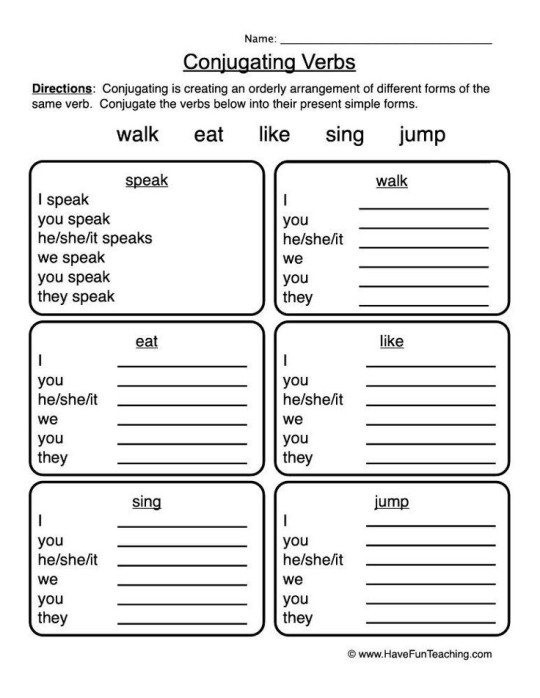
First things off, you should start by studying languages. Nobody is asking you to get fluent but it's important to understand the basic mechanics of language. You will start to see certain tricks to language, how verbs are conjugated and how gender effects certain words. It will be easier to make up your own when you know these tricks. For example, in Irish one doesn't scold but "gives out to" - "a thabhairt amach". In German, numbers are arranged differently to the English with the smallest digit arranged before the tens for example 21 - Einsundzwanzig. By immersing yourself in an array of different languages (I recommend finding ones close to how you want your language to sound), you can gain the tools necessary for creating a believable language.
Keep it Simple

Nobody expects you to pull a Tolkien or channel the powers of David J. Peterson (hail bisa vala). You're not writing a dictionary of your con-lang. You will probably use only a handful of words in your story. Don't over complicate things. A reader will not be fluent in your con-lang and if they have to continually search for the meaning of words they will likely loose patience.
Start Small

When you're learning a language, you always start with the basics. You do the exact same when writing one. Start with introductions, the names of simple objects, simple verbs (to be, to do, to have for example) and most importantly your pronouns (you will use these more than any other word, which is why I always start with them). Simple everyday phrases should always be taken care of first. Build your foundation and work your way up, this is a marathon not a race.
Music to the Ears
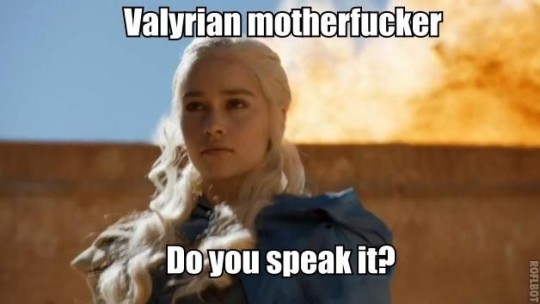
If your creating a new language, you're more than likely doing it phonetically. Sound is important to language and especially a con-lang because you want to trick your reader into thinking of a real language when reading the words on the page. I suggest sitting down and actually speak your words aloud, get the feel of them on the tongue to work out the spelling. Spellings shouldn't be too complicated, as I said before the readers aren't fluent and you want to make it easier for them to try it out themselves.
Also when you're creating the con-lang, it's important to figure out how it sounds to an unsuspecting ear. If a character is walking down a street and hears a conversation in a strange language, they will likely describe to the reader what it sounds like. It might be guttural or soft, it might be bursque or flowery. It's always interesting to compare how different languages flow in the ear.
Writing in Your Language

Now that you've written your language and created some words, you will want to incoperate them into your story. The way most writers do this is by italicising them. As a reader, I generally prefer authors not to go too overboard with their con-lang. Swathes of con-lang words might intrigue a reader but it can leave them confused as well. It is better to feed con-lang to your readers bit by bit. In most published works writer's tend to use words here and there but there are few whole sentences. For example in A Game Of Thrones by George RR Martin, has actually only a handful of short sentences in Dothraki despite the language being prevalent throughout the book. Daenerys Targaryen pronounces that "Khalakka dothrae mr’anha!"/"A prince rides inside me!" and it's one of the only sentence we actually see in actual Dothraki.
There's also nothing stopping you from just saying a language has been spoken. If you're not comfortable writing out the words, then don't make yourself. A simple dialogue tag can do the trick just fine.
Know your Words
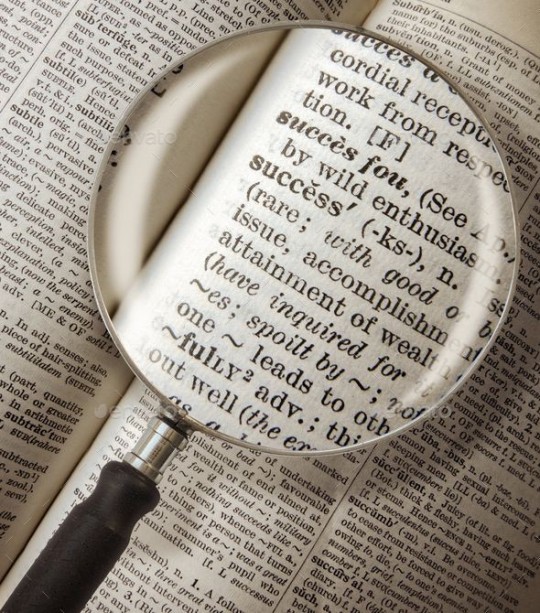
I do recommend keeping an actual record of your words. Make a dictionary if you want or a simple list of words you need. This is one of the most entertaining aspects of world building, have fun with it, go mad if you like. Also here's a short list of questions you can ask yourself about language in general which might help your juices flow.
#Fantasy Guide to Creating Your Own Language#Con-langs#Con langs#Writing a con lang#writing#writeblr#writing resources#writing reference#writing advice#ask answered questions#writing advice writing resources#writers#Writing advice writing reference#Writing reference writing advice#Writing rescources#Writing resource writing reference#Fantasy guide#Writing guide#Writing how to#nanowrimo
2K notes
·
View notes
Text
When your Character...
Gets into: A Fight ⚜ ...Another Fight ⚜ ...Yet Another Fight
Hates Someone ⚜ Kisses Someone ⚜ Falls in Love
Calls Someone they Love ⚜ Dies / Cheats Death ⚜ Drowns
is...
A Ballerina ⚜ A Child ⚜ Interacting with a Child ⚜ A Cheerleader
A Cowboy ⚜ A Genius ⚜ A Lawyer ⚜ A Pirate ⚜ A Spy
A Wheelchair User ⚜ A Zombie ⚜ Beautiful ⚜ Dangerous ⚜ Drunk
Funny ⚜ In a Coma ⚜ In a Secret Society ⚜ Injured ⚜ Shy
needs...
A Magical Item ⚜ An Aphrodisiac ⚜ A Fictional Poison
A Coping Strategy ⚜ A Drink ⚜ A Medicinal Herb ⚜ A Mentor
Money ⚜ A Persuasion Tactic ⚜ A Quirk ⚜ To be Killed Off
To Become Likable ⚜ To Clean a Wound ⚜ To Self-Reflect
To Find the Right Word, but Can't ⚜ To Say No ⚜ To Swear
loves...
Astronomy ⚜ Baking ⚜ Cooking ⚜ Cocktails ⚜ Food ⚜ Oils
Dancing ⚜ Fashion ⚜ Gems ⚜ Herbal Remedies ⚜ Honey
Mushrooms ⚜ Mythology ⚜ Numbers ⚜ Perfumes
Roses ⚜ Sweets ⚜ To Argue ⚜ To Insult ⚜ To Kiss
To Make False Claims ⚜ Wine ⚜ Wine-Tasting ⚜ Yoga
has/experiences...
Allergies ⚜ Amnesia ⚜ Bereavement ⚜ Bites & Stings
Bruises ⚜ Caffeine ⚜ CO Poisoning ⚜ Color Blindness
Facial Hair ⚜ Fainting ⚜ Fevers ⚜ Food Allergies
Food Poisoning ⚜ Fractures ⚜ Frostbite ⚜ Hypothermia
Injuries ⚜ Jet Lag ⚜ Kidnapping ⚜ Manipulation ⚜ Mutism
Pain ⚜ Paranoia ⚜ Poisoning ⚜ More Pain & Violence
Scars ⚜ Trauma ⚜ Viruses ⚜ Wounds
[these are just quick references. more research may be needed to write your story...]
Writing Resources PDFs
#requested#writing reference#character development#writeblr#dark academia#spilled ink#writing prompts#writing inspiration#writing ideas#creative writing#compilation#fiction#light academia#literature#writers on tumblr#writing prompt#poets on tumblr#writing tips#writing advice#writing resources#updated: december 2024
24K notes
·
View notes
Text
Writing Description Notes:
Updated 9th September 2024 More writing tips, review tips & writing description notes
Facial Expressions
Masking Emotions
Smiles/Smirks/Grins
Eye Contact/Eye Movements
Blushing
Voice/Tone
Body Language/Idle Movement
Thoughts/Thinking/Focusing/Distracted
Silence
Memories
Happy/Content/Comforted
Love/Romance
Sadness/Crying/Hurt
Confidence/Determination/Hopeful
Surprised/Shocked
Guilt/Regret
Disgusted/Jealous
Uncertain/Doubtful/Worried
Anger/Rage
Laughter
Confused
Speechless/Tongue Tied
Fear/Terrified
Mental Pain
Physical Pain
Tired/Drowsy/Exhausted
Eating
Drinking
Warm/Hot
#creative writers#creative writing#fanfic review#fanfiction#fanfiction tips#helping writers#how to write#references for writers#wingfic#writer#writers#writers and poets#writers community#writers corner#writers of tumblr#writers on tumblr#writing#writing advice#writing community#writing help#writing inspiration#writing life#writing prompts#writing resources#writing tips#writing tips and tricks#writing description#descriptive writing
44K notes
·
View notes
Text
Other Words for "Look" + With meanings | List for writers
Many people create lists of synonyms for the word 'said,' but what about the word 'look'? Here are some synonyms that I enjoy using in my writing, along with their meanings for your reference. While all these words relate to 'look,' they each carry distinct meanings and nuances, so I thought it would be helpful to provide meanings for each one.
Gaze - To look steadily and intently, especially in admiration or thought.
Glance - A brief or hurried look.
Peek - A quick and typically secretive look.
Peer - To look with difficulty or concentration.
Scan - To look over quickly but thoroughly.
Observe - To watch carefully and attentively.
Inspect - To look at closely in order to assess condition or quality.
Stare - To look fixedly or vacantly at someone or something.
Glimpse - To see or perceive briefly or partially.
Eye - To look or stare at intently.
Peruse - To read or examine something with great care.
Scrutinize - To examine or inspect closely and thoroughly.
Behold - To see or observe a thing or person, especially a remarkable one.
Witness - To see something happen, typically a significant event.
Spot - To see, notice, or recognize someone or something.
Contemplate - To look thoughtfully for a long time at.
Sight - To suddenly or unexpectedly see something or someone.
Ogle - To stare at in a lecherous manner.
Leer - To look or gaze in an unpleasant, malicious way.
Gawk - To stare openly and stupidly.
Gape - To stare with one's mouth open wide, in amazement.
Squint - To look with eyes partially closed.
Regard - To consider or think of in a specified way.
Admire - To regard with pleasure, wonder, and approval.
Skim - To look through quickly to gain superficial knowledge.
Reconnoiter - To make a military observation of a region.
Flick - To look or move the eyes quickly.
Rake - To look through something rapidly and unsystematically.
Glare - To look angrily or fiercely.
Peep - To look quickly and secretly through an opening.
Focus - To concentrate one's visual effort on.
Discover - To find or realize something not clear before.
Spot-check - To examine something briefly or at random.
Devour - To look over with eager enthusiasm.
Examine - To inspect in detail to determine condition.
Feast one's eyes - To look at something with great enjoyment.
Catch sight of - To suddenly or unexpectedly see.
Clap eyes on - To suddenly see someone or something.
Set eyes on - To look at, especially for the first time.
Take a dekko - Colloquial for taking a look.
Leer at - To look or gaze in a suggestive manner.
Rubberneck - To stare at something in a foolish way.
Make out - To manage to see or read with difficulty.
Lay eyes on - To see or look at.
Pore over - To look at or read something intently.
Ogle at - To look at in a lecherous or predatory way.
Pry - To look or inquire into something in a determined manner.
Dart - To look quickly or furtively.
Drink in - To look at with great enjoyment or fascination.
Bask in - To look at or enjoy something for a period of time.
#on writing#creative writing#writing#writing tips#writers block#how to write#thewriteadviceforwriters#writeblr#writers and poets#writers on tumblr#novel writing#fiction writing#romance writing#writing advice#writing blog#writing characters#writing community#writing help#writing ideas#writing inspiration#writing guide#writing prompts#writing a book#writing resources#writing reference#writing tips and tricks#writers#writing tools#writing life#writing software
18K notes
·
View notes
Text
Writing References: Character Development
50 Questions ⚜ Backstory ⚜ Character-driven Story
Basics: How to Write a Character ⚜ A Story-Worthy Hero
Basics: Character-Building ⚜ Character Creation
Types of Characters: Key Characters ⚜ Literary Characters ⚜ Flat & Round Characters ⚜ Morally Grey ⚜ Narrators ⚜ Allegorical Characters ⚜ Archetypes ⚜ Stereotypical Characters
Worksheets: Backstory ⚜ Character ⚜ Kill your Characters ⚜ Antagonist; Villain; Fighting ⚜ Change; Adding Action; Conflict ⚜ Character Sketch & Bible ⚜ Protagonist & Antagonist ⚜ Name; Quirks; Flaws; Motivation ⚜ "Interviewing" your Characters ⚜ "Well-Rounded" Character
Personality Traits
5 Personality Traits (OCEAN) ⚜ 16 Personality Traits (16PF)
600+ Personality Traits ⚜ 170 Quirks
East vs. West Personalities ⚜ Trait Theories
Tips/Editing
Character Issues ⚜ Character Tropes for Inspiration
"Strong" Characters ⚜ Unlikable to Likable
Tips from Rick Riordan
Writing Notes
Binge ED ⚜ Hate ⚜ Love ⚜ Identifying Character Descriptions
Childhood Bilingualism ⚜ Children's Dialogue ⚜ On Children
Culture ⚜ Culture: Two Views ⚜ Culture Shock
Dangerousness ⚜ Flaws ⚜ Fantasy Creatures
Emotional Intelligence ⚜ Genius (Giftedness)
Emotions (1) (2) ⚜ Anger ⚜ Fear ⚜ Happiness ⚜ Sadness
Emotional Universals ⚜ External & Internal Journey
Goals & Motivations ⚜ Grammar Development ⚜ Habits
Facial Expressions ⚜ Jargon ⚜ Swearing & Taboo Expressions
Happy/Excited Body Language ⚜ Laughter & Humor
Health ⚜ Frameworks of Health ⚜ Memory
Mutism ⚜ Shyness ⚜ Parenting Styles ⚜ Generations
Psychological Reactions to Unfair Behavior
Rhetoric ⚜ The Rhetorical Triangle ⚜ Logical Fallacies
Thinking ⚜ Thinking Styles ⚜ Thought Distortions
Uncommon Words: Body ⚜ Emotions
Villains ⚜ Voice & Accent
More References: Plot ⚜ World-building ⚜ Writing Resources PDFs
#writing reference#character building#writing tips#writing advice#character inspiration#writeblr#dark academia#spilled ink#literature#writing prompt#creative writing#fiction#writers on tumblr#story#novel#light academia#writing resources#compilation requested by anon#still a bit messy & incomplete - will edit soon#will also update this every few weeks/months
12K notes
·
View notes
Text
A general cane guide for writers and artists (from a cane user, writer, and artist!)
Disclaimer: Though I have been using a cane for 6 years, I am not a doctor, nor am I by any means an expert. This guide is true to my experience, but there are as many ways to use a cane as there are cane users!
This guide will not include: White canes for blindness, crutches, walkers, or wheelchairs as I have no personal experience with these.
This is meant to be a general guide to get you started and avoid some common mishaps/misconceptions in your writing, but you absolutely should continue to do your own research outside of this guide!
This is NOT a medical resource!!! And never tell a real person you think they're using a cane wrong!
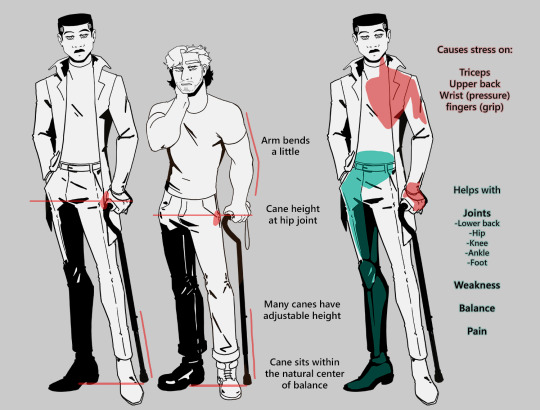
The biggest recurring problem I've seen is using the cane on the wrong side. The cane goes on the opposite side of the pain! If your character has even-sided pain or needs it for balance/weakness, then use the cane in the non-dominant hand to keep the dominant hand free. Some cane users also switch sides to give their arm a rest!
A cane takes about 20% of your weight off the opposite leg. It should fit within your natural gait and become something of an extension of your body. If you need more weight off than 20%, then crutches, a walker, or a wheelchair is needed.
Putting more pressure on the cane, using it on the wrong side, or having it at the wrong height can make it less effective, and can cause long term damage to your body from improper pressure and posture. (Hugh Laurie genuinely hurt his body from years of using a cane wrong on House!)
(some people elect to use a cane wrong for their personal situation despite this, everyone is different!)
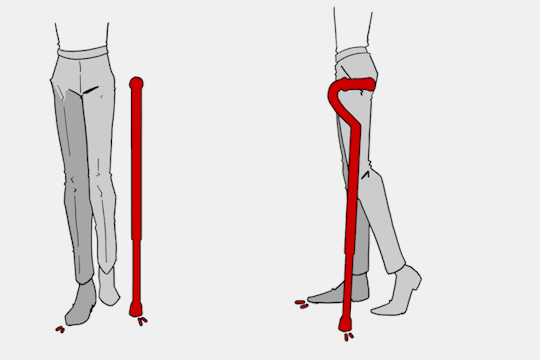
(an animated GIF of a cane matching the natural walking gait. It turns red when pressure is placed on it.)
When going up and down stairs, there is an ideal standard: You want to use the handrail and the cane at the same time, or prioritize the handrail if it's only on one side. When going up stairs you lead with your good leg and follow with the cane and hurt leg together. When going down stairs you lead with the cane and the bad leg and follow with the good leg!
Realistically though, many people don't move out of the way for cane users to access the railing, many stairs don't have railings, and many are wet, rusty, or generally not ideal to grip.
In these cases, if you have a friend nearby, holding on to them is a good idea. Or, take it one step at a time carefully if you're alone.
Now we come to a very common mistake I see... Using fashion canes for medical use!
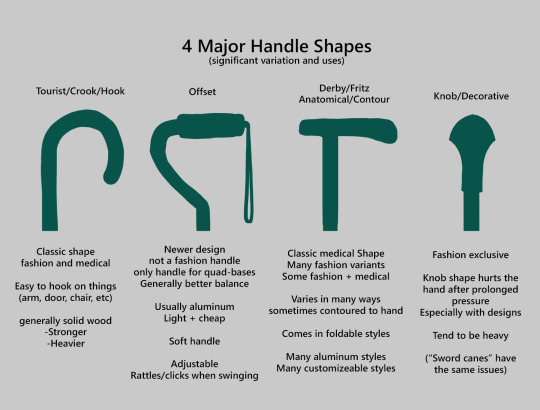
(These are 4 broad shapes, but there is INCREDIBLE variation in cane handles. Research heavily what will be best for your character's specific needs!)
The handle is the contact point for all the weight you're putting on your cane, and that pressure is being put onto your hand, wrist, and shoulder. So the shape is very important for long term use!
Knob handles (and very decorative handles) are not used for medical use for this reason. It adds extra stress to the body and can damage your hand to put constant pressure onto these painful shapes.
The weight of a cane is also incredibly important, as a heavier cane will cause wear on your body much faster. When you're using it all day, it gets heavy fast! If your character struggles with weakness, then they won't want a heavy cane if they can help it!
This is also part of why sword canes aren't usually very viable for medical use (along with them usually being knob handles) is that swords are extra weight!
However, a small knife or perhaps a retractable blade hidden within the base might be viable even for weak characters.
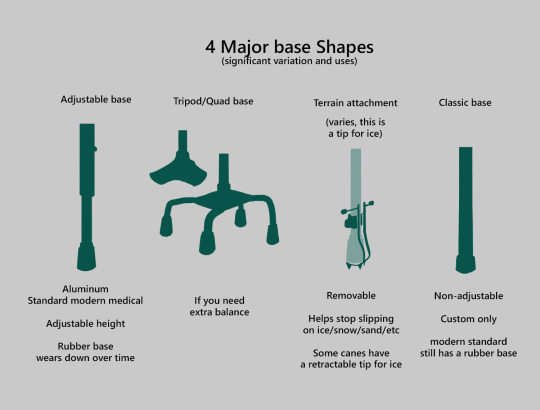
Bases have a lot of variability as well, and the modern standard is generally adjustable bases. Adjustable canes are very handy if your character regularly changes shoe height, for instance (gotta keep the height at your hip!)
Canes help on most terrain with their standard base and structure. But for some terrain, you might want a different base, or to forego the cane entirely! This article covers it pretty well.
Many cane users decorate their canes! Stickers are incredibly common, and painting canes is relatively common as well! You'll also see people replacing the standard wrist strap with a personalized one, or even adding a small charm to the ring the strap connects to. (nothing too large, or it gets annoying as the cane is swinging around everywhere)

(my canes, for reference)
If your character uses a cane full time, then they might also have multiple canes that look different aesthetically to match their outfits!
When it comes to practical things outside of the cane, you reasonably only have one hand available while it's being used. Many people will hook their cane onto their arm or let it dangle on the strap (if they have one) while using their cane arm, but it's often significantly less convenient than 2 hands. But, if you need 2 hands, then it's either setting the cane down or letting it hang!
For this reason, optimizing one handed use is ideal! Keeping bags/items on the side of your free hand helps keep your items accessible.
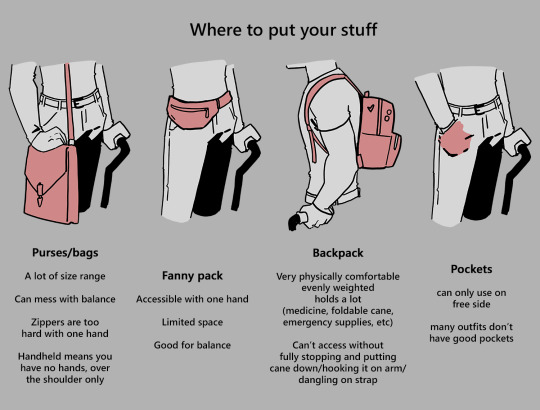
When sitting, the cane either leans against a wall or table, goes under the chair, or hooks onto the back of the chair. (It often falls when hanging off of a chair, in my experience)
When getting up, the user will either use their cane to help them balance/support as they stand, or get up and then grab their cane. This depends on what it's being used for (balance vs pain when walking, for instance!)
That's everything I can think of for now. Thank you for reading my long-but-absolutely-not-comprehensive list of things to keep in mind when writing or drawing a cane user!
Happy disability pride month! Go forth and make more characters use canes!!!
#mobility aid#cane user#writing tips#writing advice#drawing tips#art tutorial#art tips#art reference#art resources#art help#my art#long post
93K notes
·
View notes
Text
Struggling with descriptors? Here are some synonyms to make your scene more interesting!
=========
Afraid
=========
Apprehensive
Dread
Foreboding
Frightened
Mistrustful
Panicked
Petrified
Scared
Suspicious
Terrified
Wary
Worried
=========
Annoyed
=========
Aggravated
Dismayed
Disgruntled
Displeased
Exasperated
Frustrated
Impatient
Irritated
Irked
=========
Angry
=========
Enraged
Furious
Incensed
Indignant
Irate
Livid
Outraged
Resentful
=========
Aversion
=========
Animosity
Appalled
Contempt
Disgusted
Dislike
Hate
Horrified
Hostile
Repulsed
=========
Confused
=========
Ambivalent
Baffled
Bewildered
Dazed
Hesitant
Lost
Mystified
Perplexed
Puzzled
Torn
=========
Disconnected
=========
Alienated
Aloof
Apathetic
Bored
Cold
Detached
Distant
Distracted
Indifferent
Numb
Removed
Uninterested
Withdrawn
=========
Disquiet
=========
Agitated
Alarmed
Discombobulated
Disconcerted
Disturbed
Perturbed
Rattled
Restless
Shocked
Startled
Surprised
Troubled
Turbulent
Turmoil
Uncomfortable
Uneasy
Unnerved
Unsettled
Upset
=========
Embarrassed
=========
Ashamed
Chagrined
Flustered
Guilty
Mortified
Self-conscious
=========
Fatigue
=========
Beat
Burnt out
Depleted
Exhausted
Lethargic
Listless
Sleepy
Tired
Weary
Worn out
=========
Pain
=========
Agony
Anguished
Bereaved
Devastated
Grief
Heartbroken
Hurt
Lonely
Miserable
Regretful
Remorseful
=========
Sad
=========
Depressed
Dejected
Despair
Despondent
Disappointed
Discouraged
Disheartened
Forlorn
Gloomy
Heavy hearted
Hopeless
Melancholy
Unhappy
Wretched
=========
Tense
=========
Anxious
Cranky
Distressed
Distraught
Edgy
Fidgety
Frazzled
Irritable
Jittery
Nervous
Overwhelmed
Restless
Stressed out
=========
Vulnerable
=========
Fragile
Helpless
Insecure
Leery
Reserved
Sensitive
Shaky
=========
Yearning
=========
Envious
Jealous
Longing
Nostalgic
Pining
Wistful
=========
#writerscommunity#writing community#writers community#writing help#creative writing#story writing#fiction writing#writers on tumblr#writeblr#writing#vocabulary#writing tips#helping writers#references for writers#writing reference#writing advice#writing resources#writing tips and tricks#grammar#english language#english#synonyms#linguistics#fanfiction tips#creative writers#fanfic tips#character building#creative expression#motivation#creative inspiration
3K notes
·
View notes
Note
advice for a character who grips control like a lifeline. who wants to be in charge of every little thing because whenever they're not in control of something something bad could happen. has happened. they can't let a single variable be wild or in someone else's hands
How to Write a Controlling Character
Backstory Rooted in Trauma or Guilt
This character likely has a history that has ingrained the belief that they must be in control or face devastating consequences. Perhaps they once trusted someone else with something crucial—a promise, a responsibility, or a life-altering choice—and that trust was broken in a way that had lasting repercussions. For example, maybe they lost someone because they weren’t “careful enough,” or they experienced a betrayal when they trusted another person’s plan.
They might frequently flash back to this moment, possibly catching themselves thinking, If only I’d been the one in control, this wouldn’t have happened. This memory fuels their need to keep a tight grip on everything, especially if they’re in high-stakes situations.
Rigid Daily Routines and Habits
This character’s day is probably packed with small rituals and routines that give them a sense of security. From double-checking door locks to setting multiple alarms, they rely on routines to give themselves a sense of order. In fact, they might be nearly ritualistic about small actions—checking emails three times before sending, never leaving a task halfway finished, or meticulously arranging their workspace.
Even something as simple as making coffee can become a precise process. If someone moves one of their tools or a file from their desk, they may feel a spike of frustration or even anxiety, seeing it as a disruption to their personal “system.” They could feel that control in their daily life is the only thing keeping chaos at bay.
Intensely Observant of Details and Mistakes
They are hyperaware of mistakes or inefficiencies in others, mentally cataloging things like a coworker’s slight lateness or a friend’s disorganization. They may feel a sense of superiority (or frustration) over people who don’t “have it together” and take it upon themselves to organize or “fix” things for others.
In conversation, they might cut people off or “correct” them even over small points, often justifying this to themselves as necessary. For instance, if someone shares a plan that seems half-formed, this character could immediately dive in, pointing out potential problems or filling in details.
Controlling Relationships and Social Situations
This character struggles in relationships where they aren’t the dominant or organizing force. They might instinctively take over when making plans with friends, micromanaging even casual hangouts to make sure everything goes “right.” For example, they might pick the restaurant, plan the travel route, and check weather forecasts��assuming that if they don’t, no one else will think of these things.
When someone resists their attempts at control, they can respond defensively, often turning cold or resentful, unable to understand why anyone wouldn’t want them to manage the situation. Statements like, “Fine, but don’t blame me if this doesn’t go well,” are frequent in their interactions.
Extreme Anxiety or Panic When Control Is Taken Away
When things go beyond their reach, this character might experience panic, as if they’re suddenly powerless. For instance, if an unexpected roadblock prevents them from handling a task (like a canceled flight they needed to board, or a plan that falls apart), they might spend hours trying to regain control, calling every contact or frantically exploring alternatives.
Their reaction may feel extreme to others. Even minor setbacks—such as a colleague taking initiative on a project or a friend planning something without consulting them—can trigger a disproportionate response, like clenching their fists, pacing, or silently stewing as they feel the situation “slipping.”
Inability to Accept Help or Collaboration
Their controlling nature makes it hard for them to collaborate, as they believe their methods are the only ones that work. For them, accepting help feels like an admission of weakness or failure, so they rarely delegate or ask for assistance. If they do reluctantly accept help, they are constantly supervising or “suggesting” things, making it feel more like they’re still in charge.
In a team setting, they might take on all the major tasks, either out of distrust in others’ abilities or a feeling that no one will match their standards. Their motto could be something like, “If you want something done right, do it yourself,” even if that means working late or burning out.
Reluctance to Show Vulnerability or Need
Since vulnerability and control rarely coexist for them, they avoid showing weakness at all costs, preferring to mask stress or struggles as “just part of the job.” If they do become overwhelmed, they’re more likely to shut people out, saying, “I’ve got it handled,” even if it’s far from true.
When people push them to let go or share the load, they might lash out, accusing others of “just not understanding.” They often see their intense responsibility as a form of sacrifice, justifying their behavior with, “If I don’t handle this, who will?”
#creative writing#writeblr#ask box prompts#how to write a controlling character#how to write#writing tips#writing advice#writing resources#writing help#writing reference#writing prompts#how to#writing tools#writing techniques#writing stuff
2K notes
·
View notes
Text
Creating Emotionally Devastating Scenes.
Crafting a scene that earns the total sympathy of your readers can be challenging, but it's not impossible. Most emotionally devastating scenes fail at two things, but when these are done right, the results can be powerful.
⚪ The Important Concepts for Writing an Emotionally Devastating Scene
1. The Build-Up,
2. Breaking the Dam.
Before I explain these concepts, let me share a case study.
⚫ Case Study
I wrote a story about a young orphan named Jackie and her younger brother. Their village was burned down, leaving them as the only survivors.
For the next few chapters, readers followed their painful journey and their struggle to survive. The younger brother had a heart problem, and Jackie vowed to become a cardiologist to save him.
She was very ambitious about it, but at the time, it was very ironic. Later in the story, when they encountered a tragic living condition with a family, the brother died while telling his sister how much he missed their parents.
When her brother was fighting for his life, she was sent out of the room, only to be let in again to see his cold, lifeless body.
⚪ Explanation of Concepts
1. The Build-Up
The build-up is extremely important when you aim to convey strong emotions. Here's a secret: if you plan for a scene with strong emotions, start leaving breadcrumbs from the very beginning of the story.
Take the previous case study. I carefully built up their journey so people could easily relate and feel the pain of the older sister during her brother's sudden death.
You need to give the situation enough reason to feel utterly hopeless and devastating. Gradually cultivate the tension until it's ready to let loose.
⚫ Understanding the Use of Breadcrumbs.
Breadcrumbs in stories ensure you utilize the time you have to build up certain emotions around your characters.
At the beginning of my story, Jackie’s fate was already pitiable, but she survived every hurdle. This gave the readers enough to feel for her while still leaning away from the outcome. When I built enough, I introduced her brother's sudden death.
Hence, leave your breadcrumbs while leaning away from the outcome.
⚪ How to Properly Leave Breadcrumbs
When building up your story, consider these elements:
☞ Character Relatability: The characters need to be realistic to draw readers into the story. This helps readers invest themselves in your story.
☞ Realistic Emotional Pain: Just as characters need to be relatable, their emotions need to be realistic and not appear forced.
☞ Create a Strong Emotional Attachment: Give them something they care about or that has the power to ruin their lives in any way. It could be something that makes them happy or something their happiness relies on. When it's time, snatch it away without remorse.
☞ Have a Backstage Struggle: This struggle keeps readers occupied, so they won't see the outcome coming. For example, Jackie’s constant struggle to find food and shelter keeps readers engaged while the impending tragedy looms in the background.
☞ Attach Believable Elements: For a realistic character, emotion, and struggle, attach believable elements. It could be death, ailments, sickness, disorder, disappointment, failure, etc.
Now that we've covered the build-up, let's move on to the next crucial part.
2. Breaking the Dam
This is when you make your readers feel the strong emotions alongside your characters. All the tension you’ve been building up is released, making all emotions come into play.
☞ Break Your Strong Attachment: Cut off your strong attachment from your character when they least expect it or at a point when they couldn't use more struggles (i.e when they are helpless).
This will not only evoke readers’ emotions but also pique their curiosity as they wonder how the character will survive the situation.
☞ Description of Sensory Details to Invoke Emotions: The advice of "show, don't tell" will be really helpful here. It's crucial to ensure that the final execution matches the build-up.
A well-crafted build-up can fall flat if the emotional release isn't handled effectively. To avoid this, blend the climax seamlessly into the narrative, making it feel natural and impactful.
Reblog to save for reference! 💜
#writing#writeblr#writers on tumblr#writer#writers and poets#writerscommunity#writing community#wattpad#ao3 writer#a03 writer#writers of tumblr#aspiring author#aspiring writer#writing advice#writing blog#creative writing#writing discussion#writing encouragement#writing guide#writing help#writing ideas#writing journey#writing life#writing motivation#writing novels#writing on ao3#writing process#writing resources#writing reference#writing requests
2K notes
·
View notes
Text
Grumpy x Sunshine – Romantic Gestures They’d Actually Do
GRUMPY’S VERSION OF ROMANCE (Spoiler: It’s Feral and Subtle)
They’re emotionally constipated and probably communicate in grunts, but when they fall? They fall hard. Their gestures are quiet, practical, but deeply telling.
╰ Acts of Silent Protection They walk on the outside of the sidewalk. They check your tires. They hand you your umbrella without a word when it rains. They love you like a bodyguard with a soft spot.
╰ “I Noticed You’re Tired, So I Took Over” Energy They won’t say, “You deserve rest.” They’ll just do the laundry, make sure you eat, and leave you alone with a hot drink and a blanket like a cryptic little caretaker.
╰ The Reluctant Vulnerability Gift “I saw this and thought you’d like it. It’s dumb.” (It’s not dumb. It’s a first-edition copy of your favorite book. And they had to talk to a bookseller. The horror.)
╰ Jealousy in Microdoses The way their jaw tightens when someone flirts with you. The “I’m fine” that clearly means I will fight for your honor, please let me.
╰ Being Soft Only for You Sunshine gets to see the grumpy one laugh, maybe cry, maybe be human for once. If they fall asleep on you mid-rant, that’s basically a marriage proposal.
SUNSHINE’S VERSION OF ROMANCE (They’re Basically a Walking Hallmark Card)
They love big, loud, and with no chill. Their gestures are joyful, sometimes chaotic, and always from the heart.
╰ Loving the Grump Out Loud Compliments like confetti. Constant check-ins. Arms flung around them in front of people, daring them to pretend they’re not affected. (They are. Deeply.)
╰ Baking When They’re Sad “Oh, you’re mad? Here, I made brownies shaped like hearts. Do you want to talk about it or just eat six?”
╰ Pet Names for DAYS Babe, sweetie, honey-bear, muffin. Even “angry cloud man.” Sunshine will name their grumpy love interest like they’re a collection of Build-A-Bears.
╰ Surprise Playlists and Stickers on Their Laptop “This song made me think of you!” / “I put a little cartoon possum sticker on your laptop because it looks like you when you’re mad!”
╰ They Bring the Spark Back Sunshine doesn’t just love. They light up the relationship, especially when the grump forgets what it’s like to feel safe or wanted. That’s not just cute. That’s healing.
#writing#writerscommunity#writer on tumblr#writing tips#writing advice#character development#writer tumblr#writblr#writing help#grumpy and sunshine#grumpy#writing romance#writing reference#story prompt#writing prompts#romantic gestures
1K notes
·
View notes
Text
Words to Use Instead Of...
Beautiful
stunning
gorgeous
breath-taking
lovely
jaw-dropping
pretty
glowing
dazzling
exquisite
angelic
radiant
ravishing
excellent
ideal
sightly
wonderful
elegant
bewitching
captivating
mesmerizing
enthralling
magnetic
impressive
tasteful
charming
desirable
enchanting
Interesting
stricking
unusual
appealing
absorbing
srresting
gripping
riveting
alluring
amusing
exceptional
fascinating
impressive
provocative
prepossessing
exotic
readable
refreshing
entrancing
exceptional
Good
honest
upright
dutiful
enthical
pure
guiltless
lily-white
reputable
righteous
tractable
obedient
incorrupt
respectable
honorable
inculpable
irreprehensible
praiseworthy
well-behaved
uncorrupted
irreproachable
Awesome
wondrous
amazing
out-of-this-world
phenomenal
remarkable
stunning
fascinating
astounding
awe-inspiring
extraordinary
impressive
incredible
mind-blowing
mind-boggling
miraculous
stupendous
Cute
endeaing
adorable
lovable
sweet
lovely
appealing
engaging
delightful
darling
charming
enchanting
attractive
bonny
cutesy
adorbs
dear
twee
Shy
modest
self-effacing
sheepish
timid
way
reserved
unassured
skittish
chary
coy
hesitant
humble
introverted
unsocial
bashful
awkward
apprehensive
If you like my blog, buy me a coffee☕ and find me on instagram! 📸
#writer#writers#creative writing#writing#writing community#writers of tumblr#creative writers#writing inspiration#writeblr#writing tips#writers corner#writers community#poets and writers#writing advice#writing resources#writers on tumblr#writers and poets#helping writers#writing help#writing tips and tricks#how to write#writing life#let's write#resources for writers#references for writers#writers block#ao3 writer#writerscommunity#female writers#writer things
7K notes
·
View notes
Text
Etiquette of the Edwardian Era and La Belle Époque: Tea

This is a new set of posts focusing on the period of time stretching from the late 19th century to the early 20th Century right up to the start of WWI. I'll be going through different aspects of life. This series can be linked to my Great House series as well as my Season post and Debutant post.
Today will be focusing on the rules of tea with this time period.
Tea was a staple in society, not only as a comforting beverage but as a social gathering beset by strict rules. Etiquette at tea is not only important for guests but is a sign of respect to one's host.
High Tea vs Afternoon Tea

You're reading both terms and you're thinking high tea is the formal version and afternoon is informal. In fact, no. It is the opposite. High tea was actually served far later, about 6pm/7pm and focused on more savoury, substantial dishes. High tea was more of a lower class tradition, designed to fill the stomachs of hungry workers. The word "high" is derived from the tall tables used. Afternoon tea is served at 4pm, designed to fill the gap between lunch and dinner. Afternoon tea is served at low tables with all the guests seated and involve a lighter meal, more nibbles than anything.
Hosting and Attending Tea

Tea is an event that happens every day, it's not an excuse for a snack, it's a ritual. One can have tea served in one's own home or at the home of a friend. One must be invited to tea, one can't just show up and expect to get fed. Tea was typically served in libraries or drawing rooms and done times outside in the gardens if weather permits. One had to dress for tea usually in comfortable but appropriate clothing. Men would wear suits, women would wear tea gowns or a simple gown - keeping their hats upon their head, if they are visiting. Tea was not poured by the footman but by the host or if it is a large party, by one assigned guest. The hostess or designated tea pourer would serve themselves last.
The Tea Set

Tea sets are highly coveted and much remarked upon at tea. One would usually inherit a service (that's what the collection was called) or be gifted it at one's wedding. Services would all match and most households had different kinds, the best usually reserved for important guests.
Teapot: the tea pot held the hot water and tea leaves was was usually made of china and decorated.
Cups: the cups were generally low, shallow.
Saucer: a small plate for the cup to rest on
Tea cannister: where dried tea leaves would rest until needed.
Sugar bowl: was a small container made of china with a cover to protect the sugar from moisture.
Milk jug: a container for the milk
Slop basin: was a porcelain dish used for disposing tea leaves left behind with the dregs of tea.
Tea spoon: small spoon used to stir tea
Side Plate: small serving plate used for food.
As you might have noticed, other than a tea spoon, cutlery is not listed. There would be a spoon for jam and a knife for a scone, most food was designed to be eaten with one's hands.
There is also one instrument not listed here and it's the most recognisable thing at afternoon tea.
The Tiered Tray

The tiered tray is a set of trays stacked upon one another holding on each one, a different course. Sandwiches and savouries were served on the bottom (Favourites include smoked salmon, cucumber, cress, egg salad sandwiches), scones on the second and sweeter delights served on the top (sponge cake, macaroons, pastries etc). One would begin ay the bottom and work one's way upward.
Making the Perfect Cup of Tea in the Edwardian Era/Belle Epoque/Gilded Age

Disclaimers: Let's make one thing clear. Tea is not prepared one way for all. Tea is culturally important across the world and every culture has their own rules about how tea is consumed and served. There's no one right way.
I will be discussing the English way of brewing tea in this post.
As mentioned before, tea is held in a cannister before use. Tea leaves were added to the hot water and lightly stirred.
Controversially for most people, milk was commonly added first.
One would then set a strainer in one's cup, tilting the pot. The strainer will catch the leaves and leave your cup almost tea-pulp free.
With the tea added, one could add in sugar. The trick is not to make a show about it or be too loud. One simply should gently turn your spoon from the 6 o'clock position to the 12 o'clock position. Also, the spoon rests on the saucer when not in use and doesn't stay in your cup.
When drinking your tea, put your pinky down. That's an American myth. Simply lift your cup to you, lifting the cup to your mouth by the handle. Saucers are not lifted unless your cup is far away. Don't slurp it, there's plenty more where that came from.
Etiquette at Tea

Afternoon tea is for light conversation, do avoid heavy topics.
Listen attentively when being spoken to.
Don't talk with your mouth full or stuff your mouth. Typically everything should be polished off with 2-3 bites.
Gloves should be removed at tea because one is eating with their fingers.
If one is leaving the table to go to the bathroom or a breath of air, simply turn to your neighbours and excuse yourself. No explanation needed.
Napkins should be removed from the table and set across one's lap when one is sitting down. When finished with tea, set it beside your plate before you rise.
Also you daub, not smear.
Don't cut your scone but break it.
Don't lick your fingers.
Don't bang the spoon on the side of the cup.
Also there's no dunking biscuits into your tea. It's just not done at afternoon tea.
Never thank the staff for fetching anything - or at very least, don't be overhead doing so.
Always say your goodbyes to the hostess and compliment the tea, even if you had a rubbish time.
Also most importantly, never criticise somebody else's manners. That's the height of rudeness.
#Etiquette of the Edwardian Era and La Belle Epoque#Tea#Afternoon tea#High tea#Tea party#Edwardian Era#Gilded age#Belle Epoque#writing resources#writing reference#writing advice#ask answered questions#writing advice writing resources#writers#writeblr#writing#writing research#Writing resources writing reference#Writing reference writing advice#Writing advice writing reference#Fantasy guide
914 notes
·
View notes
Text
On conditioned whumpees...
Y'know, I think one of the things that people get wrong with conditioned whumpees is their rules. Specifically, when a whumpee was in long term captivity/training and they later get released or escape.
Most people write them as latching onto a caretaker or new whumper, and begging for new rules so they know they're doing something right. A new set of laws to live by, a new framework to behave to.
And that's... not really how conditioning works.
Conditioning means automatic reactions. Your body doing something that was trained into you without consulting your brain first.
There is no decision making. There is no choice. The trigger hits, and you are immediately performing the correct action regardless of anything else.
You're told to kneel? Your knees have already hit the ground. You're supposed to be standing in one part of the house when a certain noise is made? You've launched into movement before you even realize what you heard.
These rules are woven into the fabric of your body. And they are insurmountable. The conditioning overrides emotion, internal conflict, hesitation, beliefs, wants... everything.
Your whumpee may very well hate what is being done to them, and after the moment has passed they're cursing themself and their whumper. They're still a person on the inside. And that person is still very much alive. Most of the time, they will have some level of awareness that what's being done to them is wrong. They'll be angry. They'll be hurt. And they will hate that there is nothing they can do about it.
But the next time that trigger occurs, the response still hits them exactly the same.
So now take your whumpee out of that situation. They ran away, were rescued, were sold. They got out. Now they're with new people, a new caretaker, a new whumper. Or they're on their own and trying to make their own way in the world.
But those conditioned responses are still there.
There's no turning them off. You don't just replace them with new rules. They are in your every fibre. They have been built into the very framework of who you are.
The next time someone says the word "kneel", your knees are on the ground again. No matter where you are, or who you're with. The response happens before you can stop it. If they don't know why, everyone looks at you like you're insane. And you feel like you are.
Deconditioning is an agonizing process that takes more effort than I can even begin to describe to someone who's never experienced it.
Every time they hit that trigger, that response will still be there. Over, and over, and over, and over.
Breaking those rules down takes YEARS. And it is a constant effort that the whumpee has to choose to undergo every single time. Progress is measured milimeter by milimeter. You're told to kneel, and you kneel. You're told to kneel, and your mind catches up with the fact that you already did it— but a little sooner than it did before. Then a split second sooner. Then as you're doing it. Then you feel the impulse just before your knees hit the ground. Then you have a split-second of resistance before you go down. On and on and on and on, inching toward progress despite the fact that you're fighting with all your might. And that progress is anything but linear.
You don't just start obeying new rules. You don't latch on to your caretaker's new way of doing things and drop everything that you were conditioned to do before. These rules don't just get replaced.
Conditioning is not a belief system. It's a flinch response. Programmed deeper than the instincts you were born with.
You can be ordered not to obey the old command, and moments later when the trigger comes, you will anyway. Because in conditioning, the action comes before the choice.
These rules, these laws of your existence, come above everything else. And if your new whumper wants to replace them, they are going to have to beat the new rules into you so often and so severely that the pain becomes stronger than the old conditioning. At which point, the newly desired response will very, very slowly start to take over.
You're not swapping out new rules. You're layering new, worse conditioning on top of the old. And your brain will spend time stuck in that split-second between both responses before one finally grows stronger than the other. And even then, the change will not happen quickly.
That is what your conditioned whumpee is up against. That is what makes it such a horrible—HORRIBLE— and powerful tool.
#conditioned whumpee#writing advice#writing reference#pet whump#BBU whump#box boy universe#captive whumpee#whump writing#whump reference#whump inspiration#whump
1K notes
·
View notes
Text
Writing Tip - How To Make Fight Scenes Interesting
More writing tips
So, when it comes to writing fight scenes, as I have done quite a few of them, there's some things I keep in mind.
Ensure Consistent Character Abilities: Characters should fight consistently throughout the scene. They shouldn’t magically become stronger or weaker without a clear reason. Consistency in their abilities helps maintain believability.
Avoid Making Heroes Invincible: I prefer not to portray heroes as invulnerable, as seen in many 80s action movies. Instead, I include moments where the hero gets hit, shows visible injuries, and shows fatigue. This makes them feel more human and improves the significance of their victories. It’s hard to create a sense of urgency if the characters don’t seem to be in real danger.
Portray Antagonists as Competent: I avoid depicting random cannon fodder as foolish by having them attack one at a time or easily get knocked out. Instead, I show them employing smart tactics such as ganging up on the hero and even getting back up after being knocked down.
Incorporate the Environment: Don’t forget to include the surroundings. Whether the fight takes place in a cramped alley, on a rain-soaked rooftop, or in a collapsing building, use the environment creatively. Characters can use objects as weapons, find cover, or struggle against challenging terrain.
Highlight Self-Inflicted Pain: Characters can hurt themselves just as much as their opponents. For instance, after landing a powerful right hook, a character might need to pause and shake off their hand in pain. This not only adds realism but also highlights the toll that fighting takes on the body.
Show Consequences After the Fight: Consider what happens after the battle concludes. Do injuries slow the hero down and limit their abilities for the rest of the story?
These are just a few tips for now. I am planning to release more tips on how I write my fight scenes with some examples included. See you then!
#creative writers#creative writing#fanfic review#fanfiction#fanfiction tips#helping writers#how to write#references for writers#review tips#wingfic#writer#writers#writers and poets#writers community#writers corner#writers on tumblr#writing#writing advice#writing community#writing help#writing inspiration#writing life#writing prompts#writing resources#writing tips#writing tips and tricks#resources for writers
2K notes
·
View notes
Text
Character Flaws and Their Meanings
Impulsiveness : Acts on instinct without careful planning. Perfectionism : Sets unrealistically high standards, leading to self-criticism. Indecisiveness : Struggles to commit to decisions or choose a path. Arrogance : Overestimates one’s abilities and dismisses others. Pessimism : Habitually expects negative outcomes in most situations. Cynicism : Distrusts the motives and sincerity of others. Overconfidence : Places excessive faith in one’s skills, often underestimating risks. Stubbornness : Resists change and refuses to adapt to new ideas. Jealousy : Feels envious of others' success or possessions. Insecurity : Experiences frequent self-doubt and a lack of confidence. Procrastination : Tends to delay tasks, often leading to missed opportunities. Passivity : Avoids taking initiative and relies on others to act. Aggressiveness : Responds with hostility or force rather than reason. Selfishness : Prioritizes personal gain over the welfare of others. Fragility : Is overly sensitive to criticism and easily discouraged. Egotism : Constantly focuses on oneself and one’s own importance. Defensiveness : Quickly rejects or rationalizes away critique or new information. Manipulativeness : Exploits others to fulfill personal needs or desires. Recklessness : Shows a careless disregard for potential risks or consequences. Resentfulness : Holds lingering bitterness and grudges over perceived wrongs. Distractibility : Finds it hard to maintain focus amid competing interests. Impatience : Lacks the willingness to wait, often spoiling opportunities to learn. Perfunctory : Performs actions in a mechanical, uninspired manner. Self-Doubt : Consistently questions personal abilities and decisions. Arbitraryness : Makes decisions based on whim rather than reason or evidence. Rigidity : Is inflexible and unwilling to consider alternative viewpoints. Gullibility : Trusts too easily, often leading to being misled or deceived. Obsession : Becomes excessively fixated on particular ideas or details. Aloofness : Maintains emotional distance, appearing detached or indifferent. Intolerance : Refuses to accept differing perspectives or lifestyles.
Writing Advice for Brainstorming
Mix genres and time periods: Experiment by combining elements from different eras or genres to create unique settings and narratives.
Use "what if" scenarios: Pose unexpected questions (e.g., What if time travel operated on emotions rather than mechanics?) to spark novel ideas.
Draw from diverse mediums: Engage with art, music, or even scientific papers to inspire unexpected plot twists.
Embrace absurdity: Let illogical or surreal ideas guide you; sometimes the wildest thoughts lead to compelling stories.
Reverse clichés: Identify common tropes in your favorite genres and deliberately invert them to create fresh perspectives.
Incorporate personal anomalies: Transform your idiosyncrasies and personal struggles into rich, multi-dimensional characters.
Use mind-mapping: Visually plot your ideas in a freeform way to uncover hidden connections between disparate elements.
#writing#writeblr#on writing#writing tips#how to write#writers block#creative writing#writers and poets#thewriteadviceforwriters#writers on tumblr#writing project#fiction writing#novel writing#writing a book#writing advice#romance writing#writing characters#writing community#writing guide#writing inspiration#writing prompts#writing ideas#writing reference#writing blog#writing resources#writing help#writing software#writerscommunity#writers#writing tips and tricks
9K notes
·
View notes
Text
Writing References: World-Building
20 Questions ⚜ 100 Words for World-building
Basics: World-building ⚜ Places ⚜ Imagery ⚜ Setting
Exploring your Setting ⚜ Habitats ⚜ Kinds of Fantasy Worlds
Fantasy World-building ⚜ World-building Vocabulary
Worksheets: Magic & Rituals ⚜ Geography; World History; City; Fictional Plant ⚜ A General Template
Editing
Setting & Pacing Issues ⚜ Editing Your Own Novel
Writing Notes
Animal Culture ⚜ Autopsy ⚜ Alchemy ⚜ Ancient Wonders
Art: Elements ⚜ Principles ⚜ Photographs ⚜ Watercolour
Creating: Fictional Items ⚜ Fictional Poisons ⚜ Magic Systems
Cruise Ships ⚜ Dystopian World ⚜ Parts of a Castle
Culture ⚜ Culture Shock ⚜ Ethnocentrism & Cultural Relativism
Food: How to Describe ⚜ Lists ⚜ Cooking Basics ⚜ Herbs & Spices ⚜ Sauces ⚜ Wine-tasting ⚜ Aphrodisiacs ⚜ List of Aphrodisiacs ⚜ Food History ⚜ Cocktails ⚜ Literary Cocktails ⚜ Liqueurs ⚜ Uncommon Fruits & Vegetables
Greek Vases ⚜ Sapphire ⚜ Relics ⚜ Types of Castles
Hate ⚜ Love ⚜ Kinds of Love ⚜ The Physiology of Love
Mystical Objects ⚜ Talisman ⚜ Uncommon Magic Systems
Moon: Part 1 2 ⚜ Seasons: Autumn ⚜ Spring ⚜ Summer
Shapes of Symbols ⚜ Symbolism ⚜ Slang: 1930s
Symbolism: Of Colors Part 1 2 ⚜ Of Food ⚜ Of Storms
Topics List ⚜ Write Room Syndrome
Vocabulary
Agrostology ⚜ Allergy ⚜ Architecture ⚜ Baking ⚜ Biochemistry
Ecology ⚜ Esoteric ⚜ Gemology ⚜ Geology ⚜ Weather ⚜ Art
Editorial ⚜ Fashion ⚜ Latin Forensic ⚜ Law ⚜ Medieval
Psychology ⚜ Phylogenetics ⚜ Science ⚜ Zoology
More References: Plot ⚜ Character Development ⚜ Writing Resources PDFs
#writing reference#worldbuilding#setting#writing tips#writing advice#writeblr#dark academia#spilled ink#literature#writing prompt#creative writing#fiction#writers on tumblr#story#novel#light academia#writing resources#compilation requested by anon#will update every few weeks/months
5K notes
·
View notes